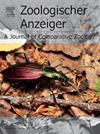A new and threatened species of internally inseminating seasonal killifish of Campellolebias (Cyprinodontiformes: Rivulidae) endemic to a continental island in the Atlantic Forest, Southern Brazil
IF 1.5
3区 生物学
Q2 ZOOLOGY
引用次数: 0
Abstract
Campellolebias comprises small internally inseminating seasonal fishes that inhabit temporary pools in tropical and subtropical areas of the Atlantic Forest. It currently encompasses four species. Integrative taxonomy was used here to investigate a possible new species found in the island of Florianópolis, southern Brazil. The examined material confirm that it pertains to a new species. Furthermore, minimum genetic distances found between this and other species of Campellolebias regarding mitochondrial markers were higher than 3 %. This new species is distinguished from all other species of Campellolebias by the combination of a series of character states, including the color pattern in both sexes, pelvic-fin bases separated by an interspace, pelvic-fin tips reaching base of the 1st anal-fin ray in males and the urogenital papilla in females, by possessing 1–2+24-29 infraorbital neuromasts, 2–4 otic neuromasts, and by the anal-fin origin being positioned at a vertical between the base of the 4th and 6th dorsal-fin ray in females. Campellolebias insularis, new species, occurs exclusively in small temporary wetlands in areas under strong threat due to real estate development, in the island of Florianópolis. Due to the advanced stage of habitat loss and degradation, its restricted distribution area, and the reduced populations sizes, the species is considered Critically Endangered. Additionally, comments are provided on the putative relationships of the new species, its conservation status, and an identification key for the species of Campellolebias.
巴西南部大西洋森林某大陆岛屿特有的一种内授精季节性鳉鱼(鲤形目:鲤科)
Campellolebias是一种小型的内部授精季节性鱼类,栖息在大西洋森林热带和亚热带地区的临时水池中。目前有四种。本文采用综合分类学方法对巴西南部Florianópolis岛上发现的一种可能的新种进行了研究。经检查的材料证实它属于一个新物种。此外,在线粒体标记方面,该物种与其他camellolebias物种之间的最小遗传距离高于3%。这一新种与其他所有的Campellolebias物种的区别在于,它具有一系列的特征状态,包括两性的颜色图案,骨盆鳍基部有间隙分隔,雄性的骨盆鳍尖端到达第1肛门鳍的底部,雌性的泌尿生殖器乳头,拥有1-2 +24-29个眶下神经突,2-4个耳神经突,通过肛门鳍的起源在雌性的第四和第六背鳍的底部之间的垂直位置。campellolbias insularis是一种新物种,只生长在Florianópolis岛上因房地产开发而受到严重威胁的小型临时湿地上。由于栖息地丧失和退化的后期阶段,其分布区域受到限制,种群数量减少,该物种被认为是极度濒危物种。此外,还对该新种的推测关系、保护现状和Campellolebias的鉴定关键进行了评述。
本文章由计算机程序翻译,如有差异,请以英文原文为准。
求助全文
约1分钟内获得全文
求助全文
来源期刊

Zoologischer Anzeiger
生物-动物学
CiteScore
2.80
自引率
7.10%
发文量
75
审稿时长
>12 weeks
期刊介绍:
Zoologischer Anzeiger - A Journal of Comparative Zoology is devoted to comparative zoology with a special emphasis on morphology, systematics, biogeography, and evolutionary biology targeting all metazoans, both modern and extinct. We also consider taxonomic submissions addressing a broader systematic and/or evolutionary context. The overall aim of the journal is to contribute to our understanding of the organismic world from an evolutionary perspective.
The journal Zoologischer Anzeiger invites suggestions for special issues. Interested parties may contact one of the editors.
 求助内容:
求助内容: 应助结果提醒方式:
应助结果提醒方式:


